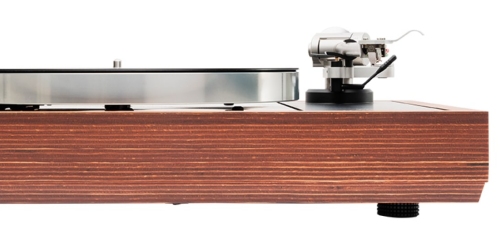First Watt SIT-4
First Watt,
October 24, 2023
The SIT-4 is the First Watt power amplifier using the industrial grade Static Induction Transistors. It is preceded by the ground breaking SIT-1, 2, and 3 and follows their technical philosophy and construction.

An important difference in the SIT-4 is the SIT device itself. The previous three designs used Silicon Carbide to make a custom vertical power Jfet with a low impedance Drain whose character nicely emulated a power Triode tube, but directly operating at the current and voltage that would drive loudspeakers without the requirement for an output transformer. SITs lend themselves to high quality audio performance with very simple Class A circuits with little or no dependence on other active circuit elements or negative feedback. The Common Source mode SIT-1 could do the job surrounded by only passive elements, and the SIT-2 required only bias from a current source. The SIT-3 upped the game with Common Drain design biased by a novel Pass circuit, MUFF (Mu Follower/Follower). The SIT-4 follows in the Common Source footsteps but ups the game with an industrial SIT. The SIT-1/2/3 gain transistors were rated at a few amps and about 50 watts dissipation. This amplifier uses a Tokin THF51s rated at 600 volts, 30 amps and 400 watts. As a practical matter, the limitations of the SIT-4 circuit are the size of the heat sinks. And this big Jfet manages a bandwidth of 50 megaHertz… The circuit of the SIT-4 is simple. Q1 is a new-old-stock Toshiba 2SK170 which drives the Gate of the Q2 SIT, whose output is biased by a mu-follower current source Q3.
Pressemitteilungsdokumente
Webseitenadresse
https://www.firstwatt.com/
More Press Releases

June 8, 2024
KEF
KEF Music Gallery Flagship Opens in London
KEF Music Gallery London is the newest and latest addition to a series of KEF Experience Locations globally, including KEF Music Galley, KEF Music Studio, and KEF Music Lounge, where KEF’s motto ‘Listen and believe’ is brought to life.
Mehr lesen

April 25, 2024
TAD
TADL INTRODUCES THE REFERENCE SERIES TAD-C700 PREAMPLIFIER
Technical Audio Devices Laboratories, Inc., today announced the TAD-C700 preamplifier as the newest addition to its Reference Series of hi-fi audio components. The new TAD-C700 incorporates a slew of technical refinements and enhancements to achieve a new level of performance, replacing the TAD-C600, TAD’s critically acclaimed, top-of-the-line preamplifier released in 2011.
Mehr lesen

January 30, 2025
Linn
Bedrok™ for Sondek LP12
Bedrok™ for Sondek LP12 is our first-ever, plinth performance upgrade. Formed of orthogonal layers of beech placed under extreme pressure and heat to create an entirely new, solid and massive material; this engineered, ultra-dense wood has negligible resonance and offers a superior isolating housing for your LP12’s mechanism.
Mehr lesen